Inbox and environment News: Issue 356
April 15 - 28, 2018: Issue 356
NOTICE: SEISMIC SURVEY UNDERWAY SUNDAY 15/4/18 NEWCASTLE AREA
Friday April 13th, 2018: NSW DPI Fisheries Asset Energy Pty Ltd have advised that they propose to undertake the Baleen two-dimensional (2D) high resolution seismic survey in offshore Commonwealth waters of New South Wales within the New South Wales Petroleum Exploration Permit PEP-11. The survey is planned to commence in daylight hours on 15th April (weather permitting) with 3-4 days duration.
The small scale, short duration survey will be acquired by an Australian utility vessel, PMG Pride, towing a 900m long submerged cable (seismic streamer) with embedded acoustic sensors and will use a single acoustic energy source of 90 cubic inch volume. Both the cable and the acoustic energy source will be towed at a depth of 3m. The cable will have a tailbuoy with a flashing white light. There will be a 2nm exclusion zone surrounding the vessel and the towed equipment for the safety of all marine users during the survey.
Upon finalisation of installation of equipment and transfer of technical personnel to the survey vessel, the vessel will transit from Newcastle port to the main operational area 30km SE of NewcastleAt this point it will commence deployment of the seismic equipment as it transits north east towards the start of the tie line that links the New Seaclem-1 well site (2010) to the main survey area.
Upon successful deployment of the seismic equipment, the vessel will commence testing of the seismic equipment at first light and will then commence the seismic survey from the tie-line point 55 km east of Newcastle, acquiring seismic data in a south-westerly direction toward the main survey grid area.
Upon reaching the main survey grid area, the vessel will continue acquisition of data along each grid line within the ~3.5km x ~3.5km grid area.
The closest distance from the coast of NSW of this area is approximately 22.5 km to Swansea Heads.
A summary of the controls in place to manage potential interactions with other marine users is:• Vessel operations will comply with all maritime legislation and guidance.• Vessel operational speed <6 knots.• Notifications to Australian Maritime Safety Authority and Australian Hydrographic Service have been issued.• Vessel will perform twice daily communications over VHF Channel 16 describing existing activities, and planned survey operations in the forthcoming 24 hours.• Vessel will maintain lighting required for marine safety.• Survey vessel will not anchor in the operational area.• Vessel will be equipped with navigational aids, radar, vessel
GPS tracking/AIS, qualified crew, vessel and management systems.For any information during the survey, please contact Toby Foster at Asset Energy on +61 8 9200 6190 or email toby@adventenergy.com.au
Update On Baleen 2D HR Seismic Survey
(The survey comprises 46 2D lines of total length 208km.) - NOPSEMA 'Not reasonably satisfied – opportunity to modify EP'Decision date: 03/08/2017 Titleholder action Resubmission due date 3: 02/09/2017Extension of timeframe: 17/08/2017 Titleholder action: 15/10/2017
Extension of timeframe: 05/10/2017 Titleholder action: 31/10/2017
Resubmission of EP: 31/10/2017 NOPSEMA decision: 30/11/2017
Request for further information: 30/11/2017 Titleholder action: 21/12/2017
Acceptance of EP: 10/01/2018 Titleholder action: 20/01/2018Decision notification (PDF 707 KB)
Submission of EP summary 19/01/2018 NOPSEMA decision 29/01/2018
Publication of EP summary 16/02/2018 -(not published/available at this date or yet - 25/2/2018)
Activity started 09/04/2018 - delayedActiviity start - Sunday April 15th, 2018
Visit:
And NOPSEMA page: Baleen 2D HR Seismic Survey: Asset Energy Pty Ltd - also: Decision notification (PDF 137 KB)
From Decision notification:Basis of decision NOPSEMA has assessed the environment plan in accordance with its assessment policies and procedures.
On completion of assessment, NOPSEMA has decided that it is not reasonably satisfied that the environment plan meets the criteria below as set out in regulation 10A of the Environment Regulations: (a) is appropriate for the nature and scale of the activity (b) demonstrates that the environmental impacts and risks of the activity will be reduced to as low as reasonably practicable (c) demonstrates that the environmental impacts and risks of the activity will be of an acceptable level (d) provides for appropriate environmental performance outcomes, environmental performance standards and measurement criteria (e) includes an appropriate implementation strategy and monitoring, recording and reporting arrangements (g) demonstrates that: (i) the titleholder has carried out the consultations required by Division 2.2A (ii) the measures (if any) that the titleholder has adopted, or proposes to adopt, because of the consultations are appropriate
Titleholder requirements For OMR decision In accordance with regulation 10, the titleholder is required to modify and resubmit the environment plan. Upon resubmission of the plan, NOPSEMA will continue to assess the submission in accordance with its assessment policies and make a decision under regulation 10. After a titleholder has been provided with reasonable opportunity to modify and resubmit an environment plan, NOPSEMA will make a final decision on whether to accept or refuse to accept the environment plan.
National Offshore Petroleum Safety and Environmental Management Authority (NOPSEMA) regulates all offshore areas in Commonwealth waters, which comprise those areas beyond the first three nautical miles of the territorial sea. This includes the Ashmore and Cartier offshore territories and offshore areas adjacent to all states and the Northern Territory.
NOPSEMA also regulates all offshore areas in coastal waters where a state or territory has conferred regulatory powers and functions. In jurisdictions where powers to regulate are not conferred, regulatory responsibilities remain with the relevant state or territory.
No Gas Drilling Off Newcastle Petition
Gas company Advent Energy has approval to start seismic exploration for oil and gas off the coast from Newcastle and the Central Coast.
Seismic exploration creates sonic underwater blasts that puts marine wildlife at risk, including migrating whales, and impacts productive local fishing grounds.
If Advent Energy finds gas, the next step will be a push for an oil and gas field off the coast off Newcastle and the Central Coast. That's a proposition the local community will never accept.
It’s not worth risking the health of the marine environment, our valuable fisheries resources and the local jobs it sustains for oil and gas exploration where the community will never accept a future gas field.
Sign the petition to say NO GAS DRILLING OFF NEWCASTLE:Dear The Premier of NSW.,
I oppose seismic exploration off the coast of Newcastle and the Central Coast and call on your Government to take steps to cancel the existing exploration licence and ban future offshore oil and gas development in NSW.
1. Seismic exploration has been shown to impact on the hearing and navigation of whales and negatively impact on marine habitat and biodiversity.
2. Offshore oil and gas exploration and drilling puts at risk local fishing and tourism industries that rely on a healthy oceans and a vibrant marine and coastal environment.
3. An oil spill off the coast between Sydney and Newcastle could be catastrophic. The risk of oil and gas leaks and spills has been shown around Australia and the world. No matter the quality of regulations, accidents happen. The risk is unacceptable.
4. NSW should be pursuing clean renewable energy, not more polluting and risk fossil fuel.
Mona Vale Beach Clean Up
Sunday, April 29 at 10 AM - 12:30 PMHosted by Northern Beaches Clean Up Crew
At Mona Vale Beach
Come and join us for our first clean up in Mona Vale. We'll meet at the area between toilet block and cafe as it’s in the middle of area to target. Some can head north through the basin and others south around cafe/ clubhouse and lawn area or down onto main beach.
We have gloves, bags and buckets. We'll clean up this area to try and catch all the litter before it enters the ocean. We're trying to remove as much plastic, cigarette butts and rubbish as possible.
We're a friendly group of people and everyone is welcome to this family friendly event. It's a nice community - make some new friends and do a good deed for the planet at the same time. Message us here if you are lost.
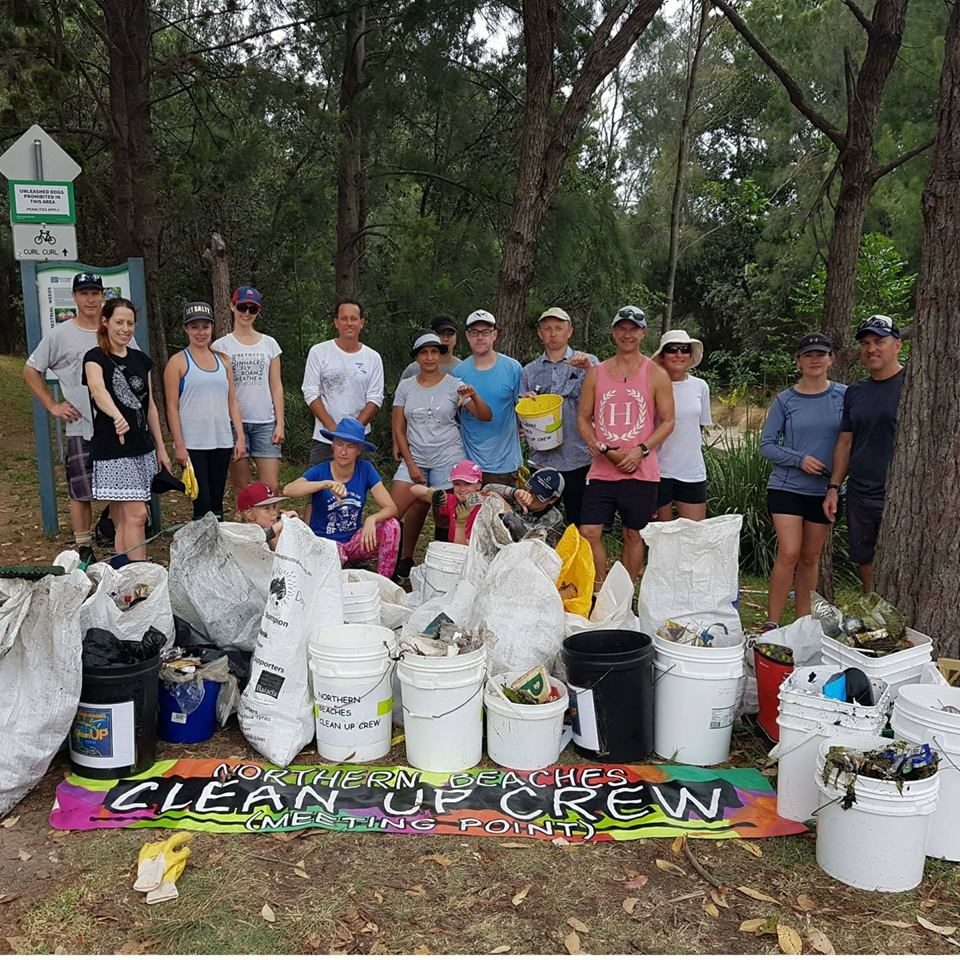

Community Members Sought For NPWS Regional Advisory Committees
April 13, 2018: NSW Office of Environment & Heritage
The National Parks and Wildlife Service (NPWS) is seeking applications from community members to nominate for membership of one of eight NSW Regional Advisory Committees. The advisory committees provide independent advice to the OEH Chief Executive, NPWS Directors and to the National Parks and Wildlife Advisory Council.
NPWS Executive Director Robert Quirk said this is an excellent opportunity for community members with a strategic interest in caring for and protecting our environment and heritage to be involved in the management of national parks and reserves into the future.
"Advisory committees provide a vital link between NPWS and the broader community, with members contributing their expert knowledge and experience to inform park management and achieve conservation outcomes across NSW," Mr Quirk said.
"The advisory committees are highly valued for their advice about NPWS policies, plans and activities, and for their input into draft plans of management under the National Parks and Wildlife Act 1974.
"We are seeking Aboriginal persons and community members with experience and expertise in one or more of the following areas: local government, conservation, Aboriginal cultural heritage, rural or regional issues, agriculture, ecotourism or ecologically sustainable visitor use, environmental education and non-Aboriginal cultural heritage conservation, or science qualifications in conservation biology, wildlife management or related disciplines," Mr Quirk said.
The eight advisory committees cover every corner of New South Wales – the Blue Mountains, Hunter Central Coast, South Coast, West, Greater Sydney, North Coast, Northern Inland and the Southern Ranges.
Members are appointed by the Minister for the Environment in a voluntary capacity for terms of up to four years. Sitting fees are not paid, but approved expenses incurred in attending meetings or conducting regional advisory committee business are reimbursed by NPWS.
Applicants are merit selected based on their relevant expertise and experience, with nominations from women, Aboriginal people, people of non-English speaking background, and young people (aged between 18 and 25) highly valued for government boards and committees.
Applications close on Tuesday 1 May 2018.Applications forms and more details are available at Advisory committees.
For more information email rac@environment.nsw.gov.au
Fox Baiting Here - Notice To Pet Owners
Northern Beaches Council is advising dog and cat owners to keep their pets away from several major reserves while fox baiting is being carried out.
Poison baits will be laid between 12 March and 1 April 2017 in the following reserves: • Manly Dam, Manly Vale• Red Hill, Beacon Hill• Dee Why Lagoon Wildlife Refuge• Oxford Falls, Morgan Road
These reserves will be closed to dogs and cats until 29 April 2018. Warning signs will also be displayed in the areas to notify the public about the program.
The fox baiting program is being conducted in conjunction with the National Parks and Wildlife Service and involves the use of “Foxoff® Econobait” poison baits, which are designed specifically for fox control. The poison baits contain 1080 (sodium monofluoroacetate).
Queenslanders Lose Out As Linc Energy Found Guilty Of Major Environmental Harm
April 10, 2018: by Lock the GateLock the Gate has slammed a weak regulatory regime which allowed Linc Energy to get away with serious environmental harm at its underground coal gasification plant on Queensland's Western Downs.
The Alliance has also raised concerns that Queenslanders will continue to lose out as it remains to be seen whether any money will be recoverable from Linc Energy or its former executives, given Linc is in liquidation.
“Linc Energy’s guilty verdict should ring alarm bells around the country - this is a dangerous, toxic industry that never should have been approved in the first place” said Lock the Gate’s Carmel Flint.
“As well as causing serious health concerns for workers, Linc Energy’s underground coal gasification plant has contaminated water, soil and air on the Western Downs, which is an agricultural powerhouse for Queensland and Australia.
"This is a terrible outcome for landholders who have been left to live with the mess created by this risky industry that should never have been approved in the first place.
“The Court heard that Linc Energy was aware of the damage it was causing but put its profits first. Linc is now in liquidation and it is unclear if, or how, they will pay if a large penalty is imposed.
“The Linc case continues a pattern of mining companies showing complete disregard for the communities they harm, and cutting and running when they get exposed for bad practices.
“It’s crucial that Linc faces a very significant penalty to send a message to other mining and gas companies and that the former executives are also held to account through Queensland’s chain of responsibility laws” she said.
Birdlife Australia - Act For Birds: Town Hall Meeting, Sydney
Date: Friday 11 May, 2018Join BirdLife in Sydney this May to hear about how nature laws are failing our birds and what we can do to help them.
BirdLife Australia is calling for stronger nature laws that genuinely protect our wonderful birds and their precious habitats. Our Act for Birds campaign is live, our report just launched, and across the environmental movement as a whole we're starting to see the extinction crisis getting the national media attention it deserves.
But our real power to secure stronger nature laws – and better outcomes for birds - lies in the stories and voices of local bird-lovers from around the country. So BirdLife will be hosting 8 town hall meetings across the country!
This series of town hall meetings will bring together people who care about birds and nature to share knowledge and take action. Attendees will get the chance to improve their understanding of this national issue, why it’s important and how it relates to you. We'll talk through exactly how the current system of nature laws is fundamentally broken and offer practical ways to take action about the local issues that matter to you.
This will be a great opportunity for passionate nature lovers (like you!) to connect with one another, come up with ideas of your own, and take action together for the places and birds you love!
Tea, coffee and snacks provided.
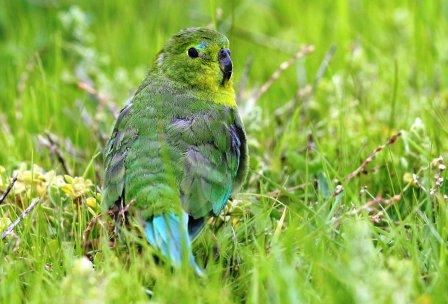

Please Help: Contribute To Significant Trees Register For Our Area
Significant trees listings wanted
Avalon Preservation AssociationThe next step in the Avalon Preservation Association's Avalon Cultural Audit is to identify and list significant trees in the area.
Roger Sayers has nominated the Spotted Gums in the reserve opposite Careel Bay Wharf.
Please help us by contributing your pick of significant trees in the area so we can map them and enter into our database.
You can either post a picture/s on the APA Facebook page and identify location of tree/s and species type if known or email us with same at secretary@avalonpreservationassociation.org.au
Our new Avalon Preservation Association Noticeboard is finally installed on corner of Belle Property Building near Herforts Chemist Old Barrenjoey Rd Avalon Beach. Many thanks to Mark Griffin Belle Property for use of wall and Robert Adema for installation.
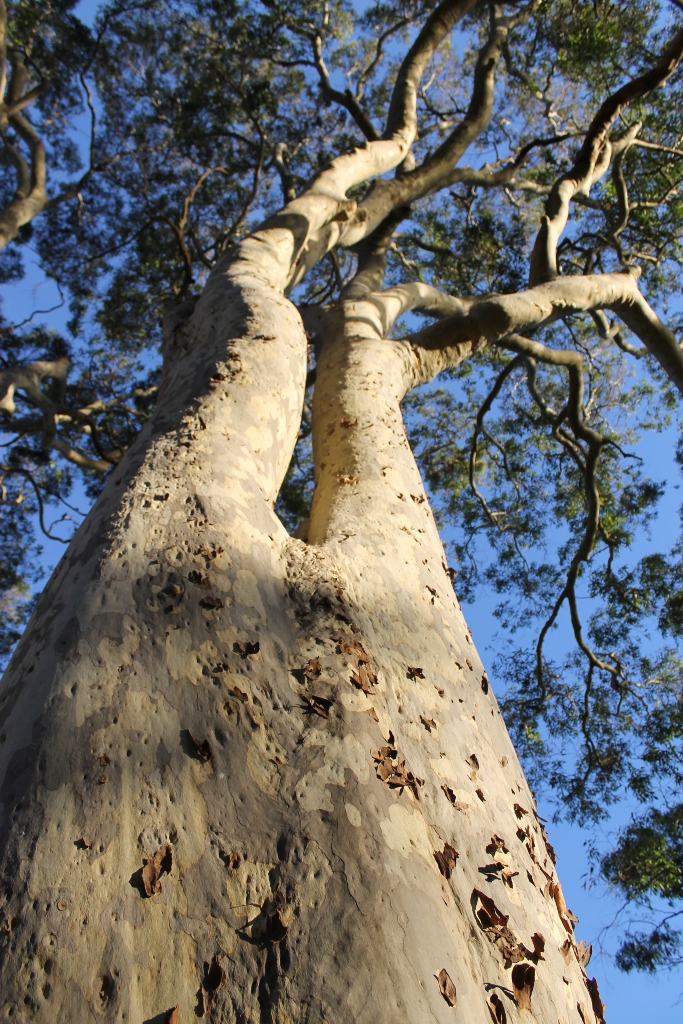

Friends Of Narrabeen Lagoon Catchment Activities
 Bush Regeneration - Narrabeen Lagoon Catchment
Bush Regeneration - Narrabeen Lagoon Catchment
This is a wonderful way to become connected to nature and contribute to the health of the environment. Over the weeks and months you can see positive changes as you give native species a better chance to thrive. Wildlife appreciate the improvement in their habitat.
Belrose area - Thursday mornings Belrose area - Weekend mornings by arrangementContact: Phone or text Conny Harris on 0432 643 295
Wheeler Creek - Wednesday mornings 9-11amContact: Phone or text Judith Bennett on 0402 974 105Or email: Friends of Narrabeen Lagoon Catchment : email@narrabeenlagoon.org.au
Upper Deep Creek Catchment walk
Sat 28/4/18 Start 10am at Terrey Hills and allow 3 hours and bring a screwdriver for some voluntary weeding near the end of the track. See and identify spectacular Sydney sandstone flora in “autumn” blossom. Carpool required. Bookings essential: Conny Harris 0432 643 295
Narrabeen Lagoon Catchment transverse Sat 19/5/18 Start 9am - finish 1.30pm.This walk is a hidden gem. Also lovely scenic views and sometimes rare fauna. Plant ID as we go and a brief lunch break BYO. Carpool back.Bookings essential: Conny Harris 0432 643 295
Cromer to Oxford Falls
Sun 10/6/18 Start 10am from Cromer Rd, allow 4 hrs and bring lunch to see great carvings near Red Hill, fantastic views over Narrabeen Lagoon and as typical for this catchment very different vegetation communities. Plant ID as we go. We will walk down to Oxford Falls and carpool back. Bookings needed: Conny Harris 0432 643 295

Looking For Nippers For Beach Environment Film
Council are seeking local Nippers to be part of a short film to help educate the community on the impact of rubbish on our beach environment. Filming is due to take place in June.
Children will be supervised and provided refreshments between shoots.
Contact their Waste teamWasteEducation@northernbeaches.nsw.gov.au or call 0438 649 528 for more information.

Photo by A J Guesdon, 2015

Plans Finalised For Australia's Marine Parks
Friday April 13th, 2018: Media release - Parks AustraliaParks Australia is pleased to report that the Minister for the Environment and Energy, the Hon Josh Frydenberg MP, has finalised plans for marine parks in the South-west, North-west, North, Temperate East and the Coral Sea. The plans were introduced into Parliament on Wednesday 21 March 2018. We would like to thank everyone for your involvement and interest in caring for our oceans. The plans are the result of significant input and assistance from a range of experts and interested parties. They are the culmination of bioregional planning processes, an independent review, economic analysis and feedback provided by many interested individuals and through the various statutory consultation processes. The finalisation of these plans means that all marine parks managed by the Australian Government will have plans in operation to care for these valuable public assets from 1 July 2018. Parks Australia is gearing up to manage our marine parks in close collaboration with marine users, in line with the strategic intent, programs, prescriptions and rules in the plans. We look forward to engaging closely with users of Australia’s marine parks and working together to manage these parks for all Australians. Parks Australia is currently putting the finishing touches to a new online application system for authorisations and we will soon start the process to establish advisory committees and forums for each network and the Coral Sea, to help guide our programs and priority actions. We will provide you with further information as these processes develop. You can view or download the plans at parksaustralia.gov.au/marine. On this site, you will also find the Director of National Parks’ response to submissions received during the statutory consultation period and the submissions themselves.
The Federal Government Is Pushing Ahead With “The Largest Protected Area Downgrading In The World”
March 2018: Media release - WWF AustraliaThe final boundaries released by the Federal Government for changes to marine parks confirm they will be the largest downgrading of protected area the world has ever seen.
The plans ignore 80,000 submissions, including 10,000 from recreational fishers, which opposed the government’s changes.
More than 35 million hectares, an area almost twice the size of Victoria, will be removed from Australia’s marine sanctuary network. According to WWF website PADDDtracker.org, which records Protected Area Downgrading, Downsizing, and Degazettement (PADDD) around the world, no other country has ever removed protection from that large an area on land or sea. “This will send Australia’s reputation for marine conservation from the penthouse to the outhouse,” said WWF-Australia Head of Oceans Richard Leck. “The Coral Sea, which is the gateway to the Great Barrier Reef, is the worst affected area by far with protected areas reduced by 50%. “This expanse of ocean beside the Great Barrier Reef is the Serengeti of the Sea – still largely untouched.
“Now it will be open slather for destructive commercial fishing activities like trawling, gillnetting and longlining.
“Forty-four marine parks in Australia are affected by these changes.Forty-two marine parks are now open to the construction and operation of oil and gas pipelines,” he said.
____________________
Also: More than 1,200 scientists urge rethink on Australia’s marine park plans - September 2017 - 80 per cent of Australia's marine park waters will be opened to commercial fishing, up from 63 percent
Monitoring Reef Health In The Coral Sea
April 13th, 2018: Media release - The Hon. Josh Frydenberg MP, Minister for the Environment and EnergyThe first stage of a three-year program commissioned by Parks Australia to monitor the health of coral reefs in the Coral Sea begins this week.
The Coalition Government has provided $1,065,180 to fund the research and James Cook University will be contributing an extra $800,000 in-kind. It is just one example of how the Coalition Government is investing in important science supporting Australian marine parks.
Scientists from James Cook University and Parks Australia staff will spend a total of 100 days at sea over three years, monitoring the health of 20 large reef ecosystems each year. They will travel to some of Australia's most remote, pristine and unique reefs and will be monitoring places such as the world-renowned Osprey Reef as well as the rarely visited Mellish Reef.
In this International Year of the Reef, scientists and Parks Australia staff will gain a better understanding of coral reef ecosystems, including how reefs are connected, the impacts of coral bleaching and how reefs are recovering. They will also be looking at the levels and impact of marine debris in the region.
The Coral Sea has significant populations of internationally threatened species as well as species found nowhere else in the world. It is a popular place for fishing and diving, with visitors from around the world experiencing its offshore reefs, sand cays and deeper waters.
This significant investment builds on research collaborations between Parks Australia and James Cook University in 2016 and 2017 and shows our commitment to increasing knowledge of marine areas around Australia.
The project will provide critical insights to help Parks Australia to understand and manage the unique and precious Coral Sea marine environment under the new Coral Sea Marine Park Management Plan commencing on 1 July 2018, ensuring that these areas are managed effectively for all Australians and for generations to come.
Tree-Mendous: Sydney To Get 5 Million New Trees As Part Of $290 Million Package
April 11, 2018: Ministerial Media ReleaseFive million new trees will be planted in Sydney by 2030, making the city a greener and even greater place to live, Premier Gladys Berejiklian announced today.
The NSW Government will plant more than 380,000 trees every year until 2030 and give away another 15,000 trees to people who are branching out and building homes in new land release areas in Western Sydney.
It will more than double the tree canopy in Sydney from 16.8 per cent at present to 40 per cent. The trees will all be natives.
“With more people putting down roots in our suburbs, this tremendous initiative will improve everyone’s quality of life and leave a lasting legacy for generations to come,” Ms Berejiklian said.
“Sydney is growing, but growth should not come at a cost to the environment or local amenity.”
The announcement is part of the NSW Government’s new $290 million Open Spaces and Greener Sydney package, including $100 million to secure strategic green space, $20 million to build more than 200 new or upgraded playgrounds and $30 million to open up 81 school ovals and playgrounds for public use during school holidays.
The NSW Government is supporting the new ‘Five Million Trees’ initiative with an initial $37.5 million in funding over four years.
Minister for Planning and Housing Anthony Roberts said the money would be provided through an annual grants program that will assist tree planting initiatives across Greater Sydney.
“Planting more trees will contribute to the lowering of urban heat in Sydney and improve the environment for pedestrians at street level,” Mr Roberts said.
Commissioner of Open Space and Parklands Fiona Morrison said trees provide many benefits. The Commissioner will help co-ordinate where many of the trees are planted, to ensure a strategic approach.
“Tree canopy coverage contributes to an improvement in biodiversity habitats for species as well as providing much-needed shade for our streets and homes. Trees also improve visual amenity, landscape and a ‘sense of place’ in our suburbs,” Ms Morrison said.
Environment Minister Gabrielle Upton said the benefits from the new trees would reach beyond the communities where they are planted.
“Planting this many trees across Sydney is equivalent to taking about 355,000 cars off the road each year,” Ms Upton said.
The 15,000 trees being made available in Western Sydney will be given to people who obtain fast track complying development approval in new land release areas.
The complying development standards, which relate to issues such as building height and landscaping, have been tailored to ensure homes are well designed and protect the privacy and amenity of neighbourhoods.
For more information on the code, please visit Greenfield Housing Code.
For more information and to get involved with the Five Million Trees initiative, please visit the Five Million Tree webpage.
To get involved, plant and register your tree today at 5milliontrees.nsw.gov.au/.
Hotter, Longer, More Frequent - Marine Heatwaves On The Rise
April 11, 2018: by Alvin Stone, University of New South WalesMarine heatwaves have increased over the past century as a direct result of warming oceans, with significant impacts on biodiversity, fisheries, tourism and aquaculture.

Brain coral under a hot sun. Image: Daniel Hjalmarsson Unsplash
An international study by researchers from the newly launched ARC Centre of Excellence for Climate Extremes and the Institute of Marine and Antarctic Studies reveals that marine heatwaves have increased globally over the past century in number, length and intensity as a direct result of warming oceans.
The results are published in the journal Nature Communications.
From 1925-2016, the frequency of marine heatwaves increased on average by 34% and the length of each heatwave increased by 17%. Together this led to a 54% increase in the number of marine heatwave days every year.
“Our research also found that from 1982 there was a noticeable acceleration of the trend in marine heatwaves,” says lead author and Associate Investigator from the ARC Centre of Excellence for Climate System Science, Dr Eric Oliver, who is now based in Dalhousie University, Canada.
“While some of us may enjoy the warmer waters when we go swimming, these heatwaves have significant impacts on ecosystems, biodiversity, fisheries, tourism and aquaculture. There are often profound economic consequences that go hand in hand with these events.”
Some recent examples show just how significant marine heatwave events can be.- In 2011, Western Australia saw a marine heatwave that shifted ecosystems from being dominated by kelp to being dominated by seaweed. That shift remained even after water temperatures returned to normal.
- In 2012, a marine heatwave in the Gulf of Maine led to an increase in lobsters but a crash in prices that seriously hurt the industry’s profits.
- Persistent warm water in the north Pacific from 2014-2016 led to fishery closures, mass strandings of marine mammals and harmful algal blooms along coastlines. That heatwave even changed large-scale weather patterns in the Pacific Northwest.
- More recently still, Tasmania’s intense marine heatwave in 2016 led to disease outbreaks and slowing in growth rates across aquaculture industries. (Record-breaking marine heatwave cooks Tasmania's fisheries - ARC)
The researchers used a variety of observational datasets to reveal the trend of increasing marine heatwaves, combining satellite data with a range century long datasets taken from ships and various land based measuring stations. They then removed the influences of natural variability caused by the El Nino Southern Oscillation, the Pacific Decadal Oscillation and the Atlantic Multidecadal Oscillation to find the underlying trend.
“There was a clear relationship between the rise in global average sea-surface temperatures and the increase in marine heatwaves, much the same as we see increases in extreme heat events related to the increase in global average temperatures,” says co-author and UNSW scientist, Dr Lisa Alexander, a chief investigator with the UNSW-based Centre for Climate Extremes.
“With more than 90% of the heat from human caused global warming going into our oceans, it is likely marine heatwaves will continue to increase. The next key stage for our research is to quantify exactly how much they may change.
“The results of these projections are likely to have significant implications for how our environment and economies adapt to this changing world," she says.
Eric C. J. Oliver, Markus G. Donat, Michael T. Burrows, Pippa J. Moore, Dan A. Smale, Lisa V. Alexander, Jessica A. Benthuysen, Ming Feng, Alex Sen Gupta, Alistair J. Hobday, Neil J. Holbrook, Sarah E. Perkins-Kirkpatrick, Hillary A. Scannell, Sandra C. Straub, Thomas Wernberg. Longer and more frequent marine heatwaves over the past century. Nature Communications, 2018; 9 (1) DOI:10.1038/s41467-018-03732-9
Eric C. J. Oliver, Jessica A. Benthuysen, Nathaniel L. Bindoff, Alistair J. Hobday, Neil J. Holbrook, Craig N. Mundy, Sarah E. Perkins-Kirkpatrick. The unprecedented 2015/16 Tasman Sea marine heatwave. Nature Communications, 2017; 8: 16101 DOI:10.1038/ncomms16101

- In 2011, Western Australia saw a marine heatwave that shifted ecosystems from being dominated by kelp to being dominated by seaweed. That shift remained even after water temperatures returned to normal.
- In 2012, a marine heatwave in the Gulf of Maine led to an increase in lobsters but a crash in prices that seriously hurt the industry’s profits.
- Persistent warm water in the north Pacific from 2014-2016 led to fishery closures, mass strandings of marine mammals and harmful algal blooms along coastlines. That heatwave even changed large-scale weather patterns in the Pacific Northwest.
- More recently still, Tasmania’s intense marine heatwave in 2016 led to disease outbreaks and slowing in growth rates across aquaculture industries. (Record-breaking marine heatwave cooks Tasmania's fisheries - ARC)
Planning For The Future With Climate Change – We Owe This To You
April 12th, 2018RT HON JACINDA ARDERN, Prime Minister of New zealandTena koutou katoaI want you for a moment to think about what you will be doing in 2048. Hopefully you will of course have graduated. You may well have a mortgage. A partner. Kids. If my attempts to predict the future as a teenager was anything to go by, you will also travel on a hover board.
But what will our world be like? Our environment, and New Zealand’s place in the world?
The idea of having to think about the what ifs 30 or even 40 years before it happens is an overwhelming prospect. But the truth is, we have to.
I know that decisions we make today have a long lasting impact. But the temptation in politics for too long, has been to do everything in three year cycles. Not too think too far ahead least you have to make hard decisions. But if there is one issue that proves we just can’t operate like that anymore, its climate change.
And that is why I am here. As young people I know that you have a good grasp of the important issues of the day. You have been a part of some of the most significant. But climate change is not just another movement that is increasingly being led by you, it is one that will also cost you unless we take action.
There is another reason we are here today. I have always been a big believer of evidence informed policy making. I had to remind myself of that the first time I ever spoke about climate change 10 years ago at a public meeting, and was booed very loudly by a group that included my grandmother.
Evidence matters. Science matters. And that is why I want to acknowledge the Climate Change experts and researchers here at Victoria University who have done such excellent work to raise the profile of the problem. Your own campaigns over the last few years helped inform us and keep action on climate change on the agenda. Professors James Renwick and Tim Naish are just a few of your great spokespeople, thank you to you and your teams.
But while you do the work, it is ultimately us as politicians who have the chance to make that work a reality. And I can think of no better place start doing that, than right here in New Zealand.
When I spoke with Al Gore a few months ago I said that New Zealand’s role in climate change is anchored in who we are as a nation – we were the first to give women the vote, we were around the table when we established the United Nations, we were at the forefront of the anti-nuclear movement and this feels like the next stage for New Zealand to make a stand on an issue.
We are anchored in the Pacific – surrounding us are nations, including ourselves, who will be dramatically impacted by climate change. You can’t avoid seeing the impact around us, especially in the Pacific as warmer sea temperatures contribute to more storms, as we see more droughts and fires, and more extreme weather in general. That’s just the obvious impact of climate change. There’s also sea level rise, ocean acidification, the movement of mosquito borne diseases like zika and dengue.
Tens of thousands of New Zealanders and Pacific peoples live on the coastline and will be affected by rising sea levels. That means people may need people to move their homes, breaking up communities and causing stress and hardship. , Underground infrastructure and fresh water sources could be inundated with sea water, and crops that have previously been a staple will change or even disappear. For the pacific, this is not just a hypothetical, it is real.
On my recent visit to Samoa and Tonga I saw the damage to homes. It was devastating and wide spread. And it wasn’t just homes that were effected. Schools, parliament buildings, businesses and infrastructure like power lines that were taken out by coconut trees. Families struggling to fix their homes were sending children to school where they had to learn in tents supplied by UNICEF. The damage from these storms is immense and the reconstruction period is long and hard.
I have said in the past that I believe we have a duty to our pacific neighbours to raise the need for mitigation and adaptation in the face of these challenges. Increasingly though I have come to see that we are the pacific. When we raise these issues, and when we act on them, it will be as much about Tokelau as it is about us.
And action is taking place already. And not just by us.
Around the world we see oil companies investing billions of dollars in clean energy. Companies are investing in charging stations for electric vehicles. Oil companies themselves are looking to the future and that includes renewables. We all know we are going to have to do things differently.
Norwegian-based Energy Company Statoil has developed its own climate road map in support of the Paris Climate Agreement. It includes by 2020 putting 25 percent of its research funding into developing new energy and energy efficiency solutions, and making decisions that support a low carbon future.
You might have seen in the news over the weekend that oil giant Shell issued a report in 1988 predicting climate change and noting that with fossil fuel combustion being a major source of CO2 in the atmosphere, a forward looking approach by the energy industry was needed. They followed that up some 30 years later by this week saying they strongly support the Paris Agreement and the need for society to transition to a lower carbon future, while also extending the economic and social benefits of energy to everyone. To quote shell "successfully navigating this dual challenge requires sound government policy and cultural change to drive low-carbon choices for businesses and consumers. It requires cooperation between all segments of society."
I completely agree.
And that is why I am here with our partners, New Zealand First and our Regional Economic Development Minister Shane Jones, and the Green Party and our Climate Change Minister James Shaw, along with Energy and Resources Minister Megan Woods.
They are here because we together made it a priority as a Coalition Government to make a fresh start in tackling this problem.In striking a balance I would like to acknowledge the manner in which New Zealand First and the Green Party were able to join Labour in finding a pathway that both protects existing permit holders while signalling our shift towards a just transition in the sector.
We have a Minister for Climate Change, James Shaw, who represents us internationally, as well as leading the agenda at home. Just a few weeks ago he spoke to Intergovernmental Panel on Climate Change Working Group on Land, being held in Christchurch. There were 120 scientists and experts, from 59 countries there.
I’m sure he was proud to be able to tell them that we have committed to the goal of becoming a net zero emission economy by 2050, with an interim step of making our electricity system 100 percent renewable by 2035. They’re ambitious goals we should all be proud of.And we have to be ambitious about what we can do to make a difference. Because in this enourmous challenge we are facing, also lies opportunity for us. If we create a plan.
And this government has a plan.
Firstly, sustainable, low emission food production promises to be a valuable opportunity if we can get it right.
We are also encouraging and incentivising innovation and investment to deliver a clean, green carbon neutral New Zealand – and the Green Investment Fund will support this. It aims to stimulate up to $1 billion of new investment in low carbon industries by 2020, kick-started by a Government investment of $100 million.
As part of our regional development work and under the leadership of Minister Shane Jones, we have started a programme to plant 1 billion trees in the next 10 years. This will contribute to reducing CO2 emissions, both through C02 absorption and by reducing erosion.
We are setting up an Independent Climate Commission of experts who will develop carbon budgets right through to 2050. That means they’ll set the amount of carbon we can afford to put into the atmosphere each year to get us to carbon neutrality, while ensuring we have enough energy available to run our economy and country.
We also have to make sure that we are focused on just transitions – that in areas where fossil fuels have played a major role, we don’t switch off the tap overnight, that we make decisions 30 years in advance and invest in those regions. We have asked MBIE to start work co-ordinating this activity.
But just transitions have to start somewhere. And unless we start thinking about the when and the how now, we run the risk of local communities experiencing a jarring shock just because we didn’t think beyond short electoral cycles.
And that is why we have to consider the future of oil and gas exploration in New Zealand. Not for tomorrow, but for 30 or 40 years time.The need to transition to a low carbon economy is understood and agreed on by both sides of parliament as well as widely supported by this industry.
So it comes as no surprise that we have been considering what to do about the future of oil and gas exploration. We have previously talked about the ‘block offer’ where areas of land and sea are offered to companies for oil and gas exploration.In considering this we have been clear about two things:- We need to give certainty.
- We need a plan.
Certainty means being clear that we need to honour existing permits. And as a government, we are committed to that. In honouring these permits, we protect current jobs and businesses and provide time to work on change for the future together.
New Zealand First accentuated its support for protecting the rights of existing permit holders and this we agreed to, to ensure certainty for all those in the industry currently holding exploration and mining permits.
There are currently exploration permits that cover an area roughly the size of the North Island, and a number of mining permits. These all have a long shelf life, and a long lead time. Nothing will end tomorrow.
But certainty is also about setting our expectations for the future. And that is what we have done today.
Today we announced that onshore block offers will now be limited to acreage in the Taranaki region.
We have also announced that we will no longer be granting any new offshore oil and gas exploration permits.
This is another step on our transition away from fossil fuels and towards a carbon neutral economy.
Some will say that is not enough to prevent climate change. Of course that’s true. But as you know now, this is not the only thing this Government is doing to address climate change. The Block Offer is only one part of our plan. Climate Change Minister James Shaw may tell you more after this speech.
And this announcement is also only the beginning of our work on Just transitions. While I am reassuring people today that we are not going to rip their jobs from under them, nor leave communities to cope with change on their own, we also need to talk to them face to face about the 30 year plan.
We’ve seen before the enormous social damage done in the 1980s due to rapid, uncaring change. I’m a child of the 80’s – I grew up at a time when this country was going through incredibly difficult economic change in a very short period. People lost jobs suddenly, communities were gutted, families were displaced. I saw plenty of evidence of that growing up in Murupara and Morrinsville.
We will not let that happen here. I want to thank New Zealand first. Supporting our regions and ensuring we have a plan for the longer term, and honour our existing commitments has been a key point of advocacy for them. And last week Shane Jones started that by investing $20 million in the Taranaki region as we work towards the future.
This Government has set ambitious targets for our country – hitting these targets will have huge benefits for everyone. We protect our environment, have a healthier environment, create new jobs in new industries and can live up to our reputation as a leader on the world stage.
We have been a world leader on critical issues to humanity by being nuclear free, the first to support women’s’ vote and now we could be a world leading in becoming carbon neutral.
We owe this to future generations – but ultimately, we owe it to you.
[speech given at Victoria University, Wellington]
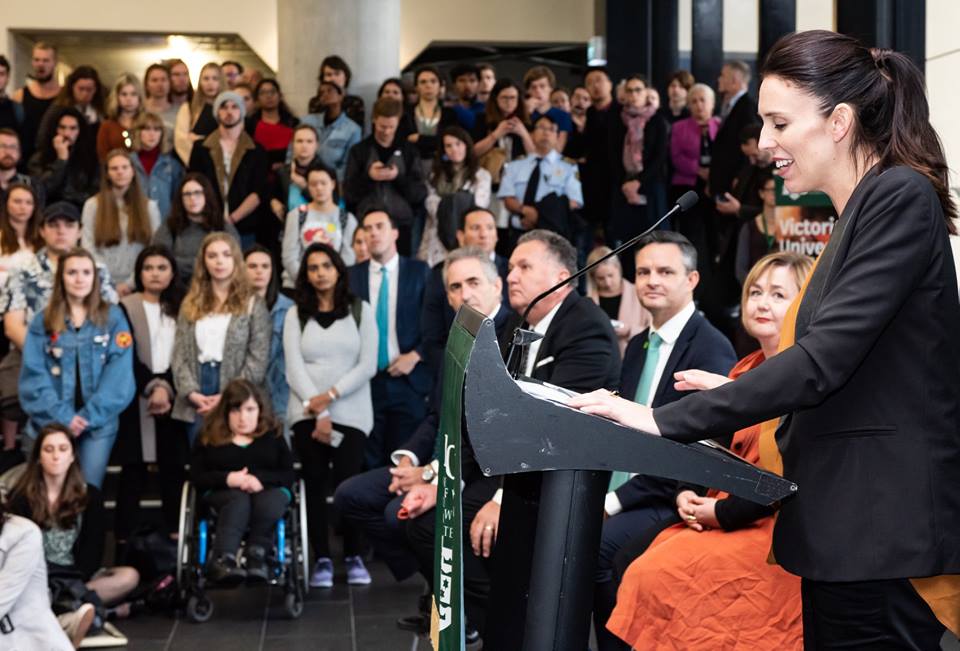
Prime Minister Jacinda Ardern at Victoria University of Wellington, photo by Victoria University of Wellington
- We need to give certainty.
- We need a plan.

An Historic Day For Action On Climate Change
April 12th, 2018HON JAMES SHAW, Climate change Minister, Government of New ZealandTena koutou, tena koutou, tena koutou katoa.
This is an historic day.
Today ends all new oil and gas exploration in the waters around Aotearoa New Zealand.
What a win.
It’s a win for the Green Party and a win for all of us who care about the environment and the impacts of climate change.
Today will go down in history as the moment New Zealand said fossil fuels are not our future.
Today we have drawn that line in the sand.
As I have said many times, the world cannot burn most of the fossil fuel reserves that have already been discovered without causing catastrophic global warming.
Anyone who wants to take real action on climate change, but still wants to keep looking for new coal or oil, simply isn’t serious.Today’s decision shows this Government is serious.
As the Green Party has been saying since we formed 20 years ago, ENVIRONMENTAL SUCCESS is ECONOMIC SUCCESS.Business now understands that.More and more farmers now understand that.
Our well-being and the well-being of our planet demand that we move to cleaner, low-emission ways of doing business and living our lives.That doesn’t mean shuffling off into a cave with a candle.
It means embracing smart science, smart technology, and smart use of people and resources that can deliver cleaner, low-emission returns.More oil exploration can’t do that.
But the expertise that’s been built up in that industry can be turned to more environmentally sustainable and economically sustainable enterprise.
The Prime Minister talked about applying skills from the oil industry to mining silica to use in solar panels.
Here’s something else.This country needs some pretty big infrastructure upgrades – to ensure safe drinking water systems and storm water systems and sewerage systems.
That’s work that needs expertise in drilling, pipe construction and reticulation, and that’s expertise that exists in the oil industry.Countries who’ve signed up to the Paris Agreement have committed to mobilize at least $1 TRILLION in Green Investment by 2030.Business consultancy, PwC, says New Zealand’s share of the global clean energy market could be worth up to $22 BILLION a year, if we implement clean energy policies to encourage it – like we did today.
This University and others in New Zealand get it.
Just go to Victoria University’s Faculty of Engineering home page.
What are two of the newest courses offered for study?
Bachelors degrees in SUSTAINABLE ENERGY SYSTEMS.
Our job, as a Government, is to provide the leadership and the plan to help ensure New Zealand is part of the world’s green, sustainable economy.
Decisions, like the one announced by the Prime Minister today demonstrate that leadership.
Establishing a Zero Carbon Act, and an independent Climate Change Commission demonstrates that leadership.
Our commitment to 100 percent renewable electricity generation by 2035 demonstrates that leadership.
And our goal for New Zealand to be a net zero emissions economy by 2050 demonstrates that leadership.
CONCLUSIONThere will be those who’ll criticize today’s decision.
My question to them is – what’s your solution?
Because sticking to business-as-usual in oil exploration will leave people like you - studying here - with bigger, more difficult, more costly problems to solve later.
Leaving decisions - like the one announced today - for future generations to make only delays and limits the options and opportunities that can come from a managed transition to a new low-emissions economy.
Clinging to old forms of energy that have helped put us on a collision course with climate change is not sensible, nor is it responsible leadership.[speech given at Victoria University, Wellington]
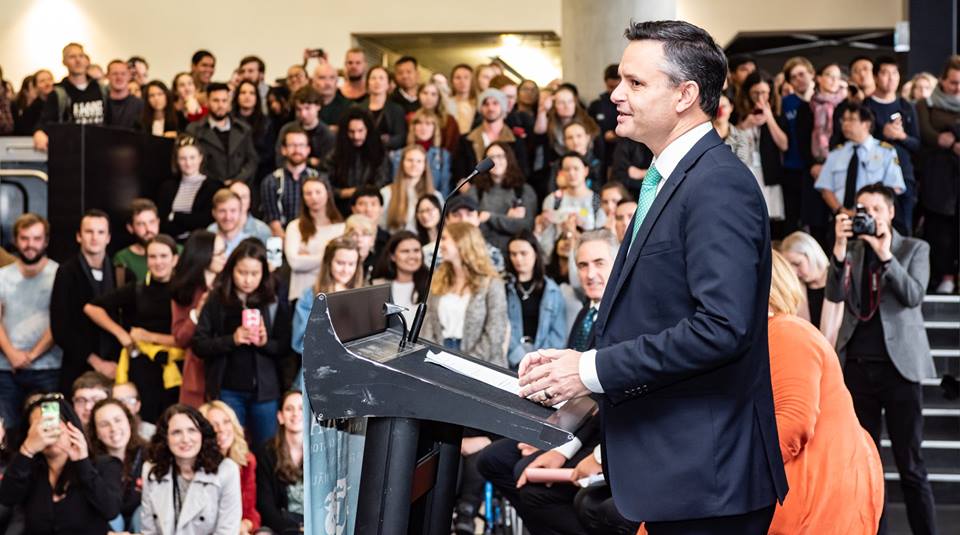
The Hon. James shaw at Victoria University of Wellington, photo by Victoria University of Wellington

Welcome End To New Offers For Offshore Oil Exploration
April 11, 2018 WWF New ZealandWWF-New Zealand welcomes today's announcement by Prime Minister Jacinda Ardern that the government will not issue any further block offers for offshore oil and gas exploration. While Energy and Resources Minister Dr Megan Woods releases a block offer for limited onshore oil exploration today, the government is announcing that it will progressively reduce new block offers for onshore oil exploration to zero.
In response, WWF-New Zealand CEO Livia Esterhazy said "This is a huge step forward for New Zealand, and a landmark moment in the transition to a clean energy economy.
"Modelling by University College London suggests that globally we need to leave about 80% of existing coal reserves, almost half of existing gas reserves and about a third of existing oil reserves un-burned to give us a reasonable chance of limiting warming to two degrees.
"This is the coal, oil and gas that has already been found and is already on the books. That is why the decision to stop opening more and more of Aotearoa's ocean territory to oil exploration is a big step towards unlocking a safe climate future.
"We hope that the New Zealand oil and gas industries will take today's announcements as a signal to use their technical skills, expertise, and resources to develop and deploy renewable energy technologies. That's the way of the future.
"What's more, today's announcement will be welcome news for New Zealand's critically endangered Māui dolphins. They live only off the west coast of the North Island, and over 30% of their habitat is already open for oil exploration. Seismic blasting for oil can both have physical impacts on dolphins and cause long-term behavioural changes.
"Today’s announcement is good news for our ocean life, for our children, and for their children."
Nanoscale Coating Enables Solar Cells To Absorb 20 Percent More Sunlight
April 14, 2018: National Institute of Standards and Technology (NIST)Trapping light with an optical version of a whispering gallery, researchers at the National Institute of Standards and Technology (NIST) have developed a nanoscale coating for solar cells that enables them to absorb about 20 percent more sunlight than uncoated devices. The coating, applied with a technique that could be incorporated into manufacturing, opens a new path for developing low-cost, high-efficiency solar cells with abundant, renewable and environmentally friendly materials.
The coating consists of thousands of tiny glass beads, only about one-hundredth the width of a human hair. When sunlight hits the coating, the light waves are steered around the nanoscale bead, similar to the way sound waves travel around a curved wall such as the dome in St. Paul's Cathedral in London. At such curved structures, known as acoustic whispering galleries, a person standing near one part of the wall easily hears a faint sound originating at any other part of the wall.
Whispering galleries for light were developed about a decade ago, but researchers have only recently explored their use in solar-cell coatings. In the experimental set up devised by a team including Dongheon Ha of NIST and the University of Maryland's NanoCenter, the light captured by the nanoresonator coating eventually leaks out and is absorbed by an underlying solar cell made of gallium arsenide.
Using a laser as a light source to excite individual nanoresonators in the coating, the team found that the coated solar cells absorbed, on average, 20 percent more visible light than bare cells. The measurements also revealed that the coated cells produced about 20 percent more current.
The study is the first to demonstrate the efficiency of the coatings using precision nanoscale measurements, said Ha. "Although calculations had suggested the coatings would enhance the solar cells, we could not prove this was the case until we had developed the nanoscale measurement technologies that were needed," he noted.
This work was described in a recent issue of Nanotechnology by Ha, collaborator Yohan Yoon of NIST and Maryland's NanoCenter, and NIST physicist Nikolai Zhitenev.
The team also devised a rapid, less-costly method of applying the nanoresonator coating. Researchers had previously coated semiconductor material by dipping it in a tub of the nanoresonator solution. The dipping method takes time and coats both sides of the semiconductor even though only one side requires the treatment.
In the team's method, droplets of the nanoresonator solution are placed on just one side of the solar cell. A wire-wound metal rod is then pulled across the cell, spreading out the solution and forming a coating made of closely packed nanoresonators. This is the first time that researchers have applied the rod method, used for more than a century to coat material in a factory setting, to a gallium arsenide solar cell.
"This is an inexpensive process and is compatible with mass production," said Ha.
Dongheon Ha, Yohan Yoon, Nikolai B Zhitenev. Nanoscale imaging of photocurrent enhancement by resonator array photovoltaic coatings. Nanotechnology, 2018; 29 (14): 145401 DOI: 10.1088/1361-6528/aaab0c

Caption: This is illustration shows the nanoresonator coating, consisting of thousands of tiny glass beads, deposited on solar cells. The coating enhances both the absorption of sunlight and the amount of current produced by the solar cells. Credit: K. Dill, D. Ha, G. Holland/NIST

Dubbo Businesswoman Wins 2018 Rural Women's Award
April 11th, 2018: Media releaseMinister for Primary Industries, Niall Blair and Member for Dubbo, Troy Grant have congratulated Dubbo’s Jillian Kilby as the winner of the AgriFutures Australia 2018 NSW-ACT Rural Women’s Award.
Premier, Gladys Berejiklian presented Ms Kilby with the award at a gala dinner at NSW Parliament House last night.
Mr Blair said Jillian’s vision of helping regional start-ups become commercial successes by increasing the capability, capacity and confidence of business owners – particularly women living in rural, regional and remote Australia – was inspiring.
“With her $10,000 bursary Ms Kilby will conduct a Regional Start-ups Insight Study to better understand the needs of regional business owners, especially those who are on the cusp of starting a new business,” Mr Blair said.
“A key focus will be women who are considering creating new businesses but need support to take their idea from concept to reality.“When women in business thrive, communities thrive too and can generate positive impacts for regional areas.
“I want to encourage women to continue to step outside their comfort zones and provide the support they need to pursue professional and personal goals.”
Mr Grant said Ms Kilby approaches life optimistically, with the logical thinking of a civil engineer, the roll-up-your-sleeves attitude of a farmer’s daughter from Coonamble, and an altruistic passion to create change across rural communities.
“Ms Kilby is well known and recognised right across the region. She is a strong advocate for regional NSW and women everywhere,” Mr Grant said.
“I look forward to seeing Ms Kilby continue to shine a light on regional business and prosper as a leader in our community.”
The NSW Government congratulates the three exceptional finalists Ginny Stevens, Shanna Whan and Olympia Yarger, who through their vision, commitment and leadership are making contributions to the primary industries sector and their regional communities.
Each finalist will receive a $1,000 NSW DPI Leadership Bursary for skills and leadership development.
Ms Kilby will now go on to compete for the National AgriFutures Australian Rural Women’s Award later this year at Parliament House, Canberra.
The AgriFutures Australia NSW-ACT Rural Women’s Award is coordinated by the NSW Rural Women’s Network a program within the Department of Primary Industries with support by NSW Farmers, Office of Environment & Heritage and The Country Women’s Association of NSW.
2018 NSW-ACT AgriFutures Rural Women's Award Finalists
Jillian Kilby, Dubbo Finalist of the 2018 NSW-ACT AgriFutures Rural Women's AwardJillian approaches life optimistically, with the logical thinking of a civil engineer, the roll-up-your-sleeves attitude of a farmer’s daughter from Coonamble, and an altruistic passion for change.
Finalist of the 2018 NSW-ACT AgriFutures Rural Women's AwardJillian approaches life optimistically, with the logical thinking of a civil engineer, the roll-up-your-sleeves attitude of a farmer’s daughter from Coonamble, and an altruistic passion for change.
Her company, The Infrastructure Collaborative, has served the infrastructure needs of 50 Local Governments in Regional NSW since 2009 when it was established from a 50,000 acre property west of Walgett. Now based in Dubbo, Jillian serves clients in Australia and the United States, where she is able to cross-pollinate learnings from a diverse set of work assignments.
Jillian enjoys taking a Design Thinking approach learned at Stanford University to solve problems and shift infrastructure projects from Government planning shelves to be shovel ready. When working on roads, Jillian refocuses infrastructure conversations around productivity for agriculture and mining, safety for school buses and access for tourism. Most importantly, she thrives when facilitating in an environment where there has traditionally been a lack of collaboration.
Jillian’s project is to improve the commercial success of start-ups by increasing the capability, capacity and confidence of regional business owners. Her bursary would go towards developing the business concept and include conducting a Regional Start-ups Insight Study. The project lives within a bigger eco system to develop more effective space and services for new and growing business owners within Dubbo and the wider catchment.
Holding a Bachelor of Civil Engineering from the University of Sydney, a Master of Business Administration and Master of Public Policy from the University of Stanford, Jillian joins the rural Women’s Award Alumni ready to learn, give back, and meet new people as part of this experience.
Ginny Stevens, Mangoplah Finalist of the 2018 NSW-ACT AgriFutures Rural Women's AwardGinny lives with her husband Andy and twins Henry and Isabella in Mangoplah in the Riverina. Having grown up on the family farm in Tasmania she has always been passionate about agriculture and staying active.
Finalist of the 2018 NSW-ACT AgriFutures Rural Women's AwardGinny lives with her husband Andy and twins Henry and Isabella in Mangoplah in the Riverina. Having grown up on the family farm in Tasmania she has always been passionate about agriculture and staying active.
Initially, Ginny’s interest with wellbeing was sparked during her year working as a jillaroo on a cattle station in the Northern Territory, where she learnt some lifelong lessons about team work, resilience and buoyancy. Then during her agribusiness banking career she became even more concerned with the growing level of mental illness and suicide in rural communities.
As a result Ginny was inspired to develop a proactive program, Active Farmers, to bring together farmers and rural communities to help improve the physical and mental health of participants and to build community resilience.
In 2015 Ginny she established the ‘Active Farmers’ program in her home town of Mangoplah and in 2017 made the brave decision to leave her Agribusiness banking career to expand the ‘Active Farmers’ network.
Active Farmers is currently available in 20 communities across regional areas of Eastern Australia with interest from an additional 60 groups.
Through exercise and interaction, Ginny says the participants become more aware of their health and they also develop a greater sense of community.
Ginny would use the Award bursary to expand the service to three additional small farming communities with little or no access to health care providers, and to create a series of case studies which will inspire other communities to join this fast growing network and take their health seriously.
Her vision is to ensure that more people understand the strong connection between being physically fit and well connected within their community to being mentally strong. She believes that healthier and happier and more productive community members will mean stronger, more productive Primary Industries.
Shanna Whan, Narrabri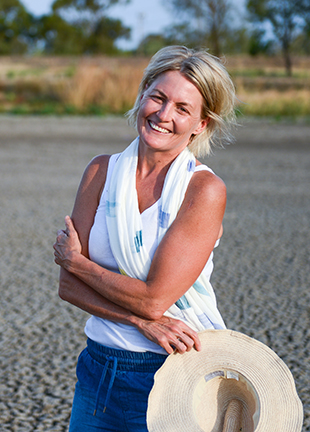 Finalist of the 2018 NSW-ACT AgriFutures Rural Women's AwardNarrabri-based Shanna Whan is a self-employed health ambassador who divides her time between travelling in her freelance photography role and working to tackle the complex issue of alcohol abuse in rural Australia.
Finalist of the 2018 NSW-ACT AgriFutures Rural Women's AwardNarrabri-based Shanna Whan is a self-employed health ambassador who divides her time between travelling in her freelance photography role and working to tackle the complex issue of alcohol abuse in rural Australia.
Shanna’s own health battle to be alcohol-free has inspired her to bring an honest and well overdue conversation about modern day addiction out into the open to help to reduce the numbers of high-risk, high-functioning community members slipping through the cracks in rural and remote Australia.
Since graduating as a health coach, Shanna is tackling head-on the fierce stigmas that remain around everyday alcohol abuse and what she’s coined ‘casual alcoholism’. Her raw authenticity in sharing her lived experience with humour and candour is giving the rural health sector and communities unprecedented insight into the issue.
There are many barriers to people seeking help with alcoholism and Shanna hopes to address these through an online platform that enables rural people to ‘virtually’ gather, chat, learn and share.
Members will have access to webinars, live support meetings, blogs and facts and links to alcohol-related therapies, experts, recovery groups and treatment centres.
Through integrating a holistic health and wellness approach, Shanna aims to provide community members who are battling with alcohol addiction a safe environment to access the support and information they need to change their lives.
Olympia Yarger, Fyshwick ACT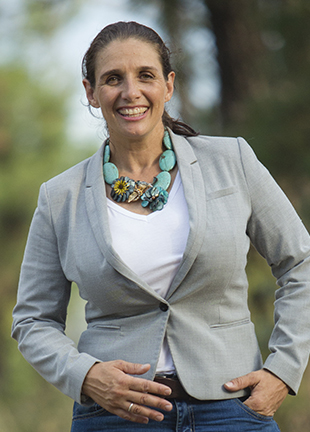 Finalist of the 2018 NSW-ACT AgriFutures Rural Women's AwardOlympia Yarger is passionate about rural and regional communities. As the Founder and CEO of Goterra, an insect farm based in Canberra, she is committed to playing a vital role in changing the landscape of Livestock feed and redefining how we look at sustainable waste management solutions.
Finalist of the 2018 NSW-ACT AgriFutures Rural Women's AwardOlympia Yarger is passionate about rural and regional communities. As the Founder and CEO of Goterra, an insect farm based in Canberra, she is committed to playing a vital role in changing the landscape of Livestock feed and redefining how we look at sustainable waste management solutions.
During her career Olympia has worked across many different agricultural industries and her roots are firmly in farming. After 14 years in America with her U.S Marine husband, she returned to Australia in 2014 with plans to pursue her farming interests.
Realising that the farming landscape had changed significantly, and the opportunity for purchasing and effectively running a small to medium sustainable enterprise was not available, Olympia researched alternate farming options which eventually led her to insect farming.
In 2016 she realised a need to unlock access to and leverage the current food and agricultural waste in rural and regional Australia and set about to address this gap by designing a modular mobile system that processes food waste onsite.
Olympia’s business processed 20 tonne of food and agriculture waste in 2017 and this year (2018) that figure will increase to over 200 tonne – turning those wastes into an alternative livestock feed compound for primary producers and human food products, like protein bars, crackers and cakes.
With the breadth and range of the insect protein industry only just starting to emerge Olympia is committed to developing the processes and industry standards necessary to bring sustainable insect protein feeds to the Australian market.
If she were to win the Award Olympia would use the Award bursary to educate people on the opportunities available to establish regionally based insect farms by developing an online education series and creating a digital handbook of best practice to grow the industry.
 Finalist of the 2018 NSW-ACT AgriFutures Rural Women's Award
Finalist of the 2018 NSW-ACT AgriFutures Rural Women's Award Finalist of the 2018 NSW-ACT AgriFutures Rural Women's Award
Finalist of the 2018 NSW-ACT AgriFutures Rural Women's Award Finalist of the 2018 NSW-ACT AgriFutures Rural Women's Award
Finalist of the 2018 NSW-ACT AgriFutures Rural Women's Award Finalist of the 2018 NSW-ACT AgriFutures Rural Women's Award
Finalist of the 2018 NSW-ACT AgriFutures Rural Women's AwardExtensive Seagrass Meadows Discovered In Indian Ocean Through Satellite Tracking Of Green Turtles
April 11, 2018: Swansea University and Deakin University.Research led by Swansea University's Bioscience department has discovered for the first time extensive deep-water seagrass meadows in the middle of the vast Indian Ocean through satellite tracking the movement of green sea turtles.
A new study by Swansea University and Deakin University academics, published in the recent Marine Pollution Bulletin, reported how the monitoring of the turtles -- which forage on seagrasses -- tracked the species to the Great Chagos Bank, the world's largest contiguous atoll structure in the Western Indian Ocean.
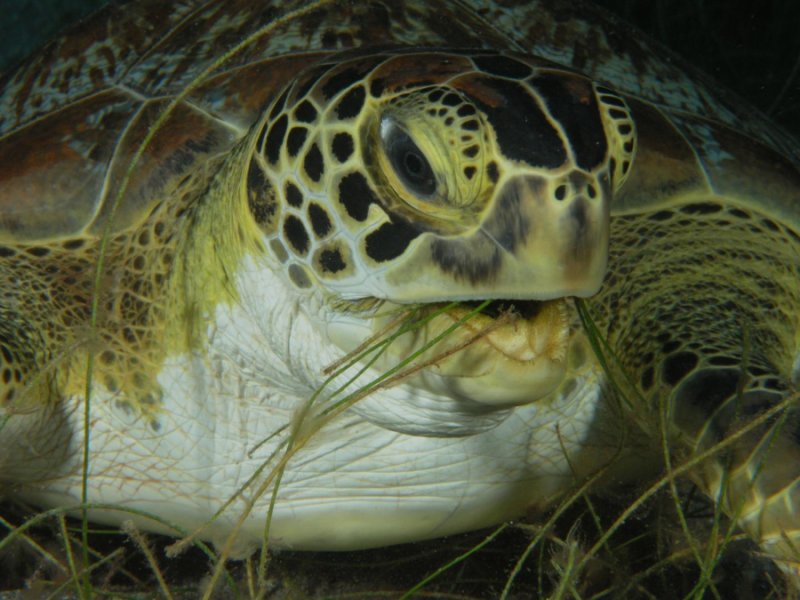
This is a green turtle with seagrass in the Caribbean. Credit: Swansea University
This area lies in the heart of one of the world's largest Marine Protected Areas (MPAs) and the study involved the use of in-situ SCUBA and baited video surveys to investigate the day-time sites occupied by the turtles, resulting in the discovery of extensive monospecific seagrass meadows of Thalassondendron ciliatum.
These habitats are critically important for storing huge amounts of carbon in their sediments and for supporting fish populations.
At three sites that extended over 128?km of the Great Chagos Bank, there was a high seagrass cover (average of 74%) at depths to 29 metres.
The mean species richness of fish in the seagrass meadows was 11 species per site, with a mean average of 8-14 species across the aforementioned three sites.
Results showed a high fish abundance as well as a large predatory shark recorded at all sites and given that the Great Chagos Bank extends over approximately 12,500?km and many other large deep submerged banks exist across the world's oceans, the results suggest that deep-water seagrass may be far more abundant than previously suspected.
Reports of seagrass meadows at these depths with high fish diversity, dominated by large top predators, are relatively limited.
Dr Nicole Esteban, a Research Fellow at Swansea University's Biosciences department, said: "Our study demonstrates how tracking marine megafauna can play a useful role to help identify previously unknown seagrass habitat.
"We hope to identify further areas of critical seagrass habitat in the Indian Ocean with forthcoming turtle satellite tracking research."
Dr Richard Unsworth, from Swansea University's Biosciences department, said: "Seagrasses struggle to live in deep waters due to their need for high light, but in these crystal clear waters of Chagos these habitats are booming.
"Given how these habitats are threatened around the world it's great to come across a pristine example of what seagrass meadows should look like."
This research was led by the Bioscience department at Swansea University, alongside the involvement of researchers at Deakin University.
N. Esteban, R.K.F. Unsworth, J.B.Q. Gourlay, G.C. Hays. The discovery of deep-water seagrass meadows in a pristine Indian Ocean wilderness revealed by tracking green turtles. Marine Pollution Bulletin, 2018; DOI: 10.1016/j.marpolbul.2018.03.018

New Study Reveals That The Centre Of The World’s Marine Biodiversity Is In Danger
April 12, 2018: Swansea University
Research led by Swansea University’s Bioscience department have found that the world’s centre of biodiversity is under widespread threat of losing a key marine resource.
Writing about the findings in the recent Science of the Total Environment journal, researchers examined the risks to seagrass meadows throughout the vast Indonesian archipelago that makes up a key part of the famed Coral Triangle – a marine area located in the western Pacific Ocean.
This area is widely known as the centre of the world’s biodiversity and the meadows are the ‘Prairies of the Sea’. They are highly productive shallow water marine and coastal habitats comprised of marine plants, and these threatened areas provide important food and shelter for animals in the sea.
The research led by Dr Richard Unsworth indicates that up to 90% of the seagrass meadows that they examined in Indonesia have been extensively damaged and degraded over the past five years.
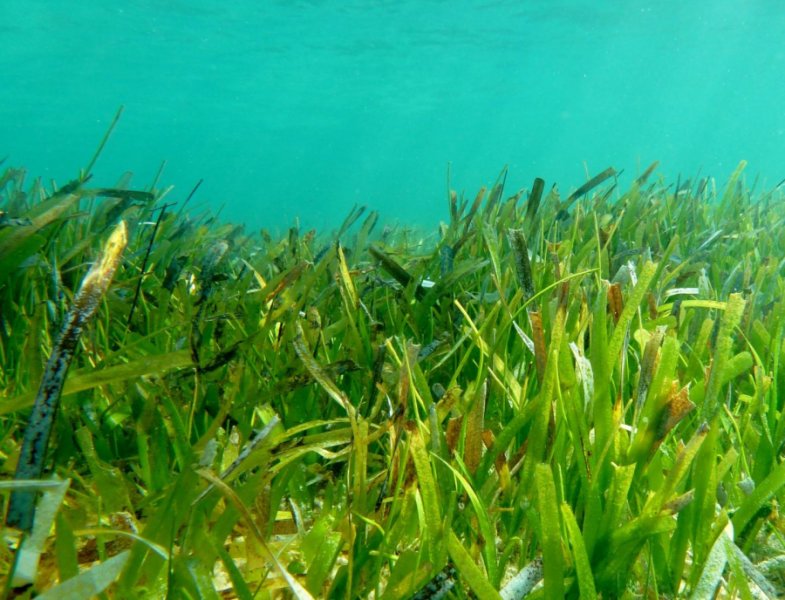
Seagrass meadows in the vast Indonesian archipelago. Credit: Dr. Richard Unsworth
In the findings, researchers also discuss solutions to the problems these productive ecosystems face, including the importance of community-led conservation action. In the study they also discuss examples where seagrass conservation has been.
For example, in a series of small islands in Eastern Indonesia, seagrasses were threatened by sediment and nutrient run-off from the land due to the degradation of riverbanks. As a result, replanting of riparian vegetation along the rivers as an incentive scheme with local farmers has reduced the flow of these pollutants into the sea.
Seagrass meadows in the vast Indonesian archipelago
Dr Richard Unsworth, from Swansea University’s Biosciences department, led the study and said:
"Our research is for the first time recording how an area of the world so critically important for its biodiversity is rapidly losing a key marine resource.
"This loss of seagrass is a terrible problem as the habitats in Indonesia have a major significance for daily food supply and general livelihoods. Without seagrass as a fishery habitat many people in Indonesia would not be able to feed their families on a daily basis."
Dr Leanne Cullen-Unsworth from Cardiff University added:
"The ecological value of seagrass meadows is irrefutable, yet the loss of these systems in Indonesia is accelerating. Seagrass meadows in Indonesia are mostly ignored in the conservation arena.
"As a result, they’re often not monitored, poorly researched and largely and unmanaged, leading to a tragedy of the seagrass commons."
Professor Rohani Ambo-Rappe of Hasanuddin University, Indonesia, a collaborator on the research, stated:
"Declining seagrass health is the result of shifting environmental conditions due largely to coastal development, land reclamation, and deforestation, as well as seaweed farming, overfishing and garbage dumping.
"The poor state of Indonesia’s seagrasses will compromise their resilience to climate change and result in a loss of their ability to lock away carbon dioxide and provide important fisheries habitats."
Richard K.F. Unsworth, Rohani Ambo-Rappe, Benjamin L. Jones, Yayu A. La Nafie, A. Irawan, Udhi E. Hernawan, Abigail M. Moore, Leanne C. Cullen-Unsworth. Indonesia's globally significant seagrass meadows are under widespread threat. Science of The Total Environment, 2018; 634: 279 DOI: 10.1016/j.scitotenv.2018.03.315
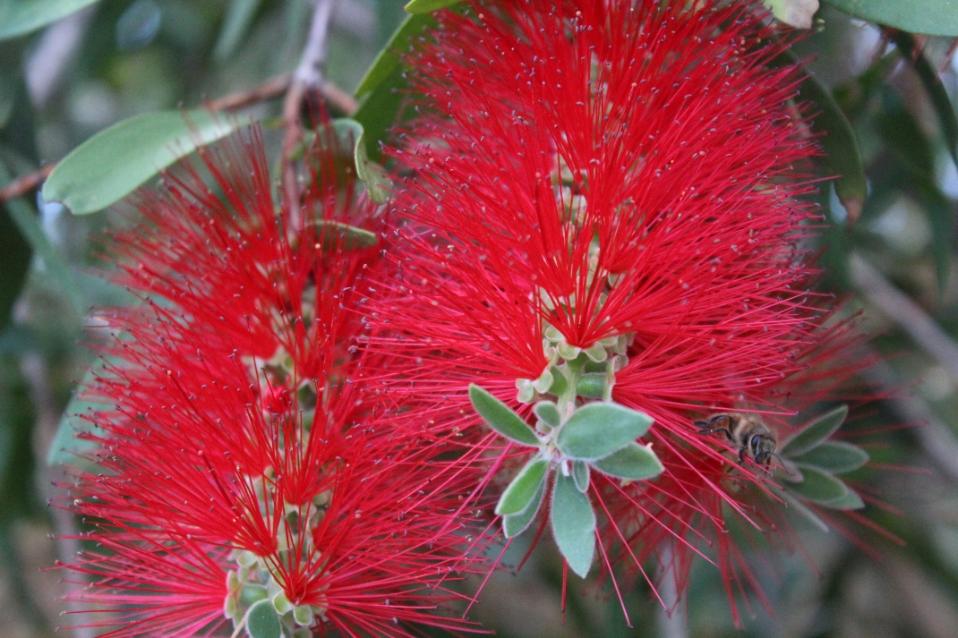 Melaleuca citrina, commonly known as common red, crimson or lemon bottlebrush, is a plant in the myrtle family, Myrtaceae and is endemic to New South Wales and Victoria in Australia. (Some Australian state herbaria continue to use the name Callistemon citrinus. Callistemon lanceolatus is an older name.)
Melaleuca citrina, commonly known as common red, crimson or lemon bottlebrush, is a plant in the myrtle family, Myrtaceae and is endemic to New South Wales and Victoria in Australia. (Some Australian state herbaria continue to use the name Callistemon citrinus. Callistemon lanceolatus is an older name.)
This is a hardy and adaptable species, common in its natural habitat. It is widely cultivated, not only in Australia, often as a species of Callistemon. It was one of the first Australian plants to be grown outside the country, having been taken to England in 1770 by Joseph Banks. Its showy red flower spikes, present over most of the year in an ideal situation, account for its popularity.
Melaleuca citrina was first formally described in 1802 by the French botanist Georges Louis Marie Dumont de Courset in Le Botaniste Cultivateur. The species had previously been known as Metrosideros citrina, in turn named by William Curtis in the Botanical Magazine in 1794, based on a flowering plant growing at Lord Cremorne's estate. That plant had grown from a root collected in 1770 at Botany Bay by Joseph Banks during the first voyage of James Cook to Australia. Curtis noted that the leaves "when bruised give forth an agreeable fragrance." The specific epithet (citrina) alludes to the similarity of the aromatic property of leaves of this species and those of citrus plants.
Callistemon citrinus is regarded as a synonym of Melaleuca citrina by the Royal Botanic Gardens, Kew.
This flower, as a flower essence (Australian Bush Flower Essences - ABFE), helps people move through major life changes and the overwhelm that often goes with those changes, especially retirement, menopause, adolescence or death, etc. It 'brushes' out the past and allows the person to move on. So relative to being seen and blooming during Autumn too!


Victoria Researchers Study Deep-Water Communities In Fiordland
April 11th, 2018A Victoria University of Wellington (N.Z.) research team has uncovered new insights on marine life in the rarely explored deeper waters of Doubtful, Dusky, and Breaksea Sounds in the Fiordland (Te Moana o Atawhenua) Marine Area.
Led by Associate Professor James Bell, the Victoria University research team used funding from the Department of Conservation (DOC) to complete the trip and spent ten days aboard the DOC vessel, Southern Winds, in Fiordland researching marine life living up to 300 metres below the sea.
The team included five PhD students and a recent graduate of Victoria University, Dr Joseph Marlow.
“This is one of the first studies to measure the abundance of the different organisms in these deep water environments,” says Associate Professor Bell. “We were able to record the marine life unique to the area, such as sharks and black coral, which occur at amazingly shallow depths in the fiords. Based on our observations so far, we think we’ll be able to describe the characteristics of many species that haven’t been described before, which is very exciting.”
The research team used a Baited Underwater Video System (BUV) to identify carnivorous and scavenging fish living up to 300 metres deep. The system uses a container filled with bait to attract the fish, and then records them using a camera attached to the baiting system. The team also used a remotely-operated underwater vehicle to survey the seabed in shallower areas of the fiords (down to 130 metres), recording the incredibly diverse anemones, sponges, coral, and brachiopods (shellfish similar in appearance to clams) living there.
The data gathered by the expedition will provide important information to help protect the area from the impact of humans.
“As well as describing the deep-water communities and supporting ongoing management, this work will provide data that can be used in the future to assess any changes that might occur as a result of humans, such as climate change or pollution,” says Associate Professor Bell.
“This trip was a fantastic opportunity for our PhD students to be part of a pretty unique research trip to one of the more remote parts of New Zealand,” says Associate Professor Bell. “It was also a great opportunity to provide research expertise for DOC, as well as support the ongoing work by local conservation group the Fiordland Marine Guardians.”
The research group produced the following video from footage taken during their trip.
The first part of the video shows footage taken using the BUV. This video shows some of the common species encountered: hapuku, spiny dogfish, blue cod, terakihi, sevengill sharks, red gurnards and hagfish.
The second part of the video shows footage taken by the remotely-operated underwater vehicle. The footage highlights the diversity at the benthic level (the bottom of a body of water including the sea floor) of the fiords; revealing extensive brachiopod beds (a species of shellfish similar in appearance to clams), large anemones, diverse gatherings of sponges and a variety of deep sea coral species.
PITTWATER YHA OFFERS FREE BEDS FOR GREEN HEARTS
Pittwater YHA opens its doors to green-hearted and green-thumbed guests who'll save the gorgeous Ku-ring-gai Chase National Park from imminent asparagus fern invasion. Yes, seriously.
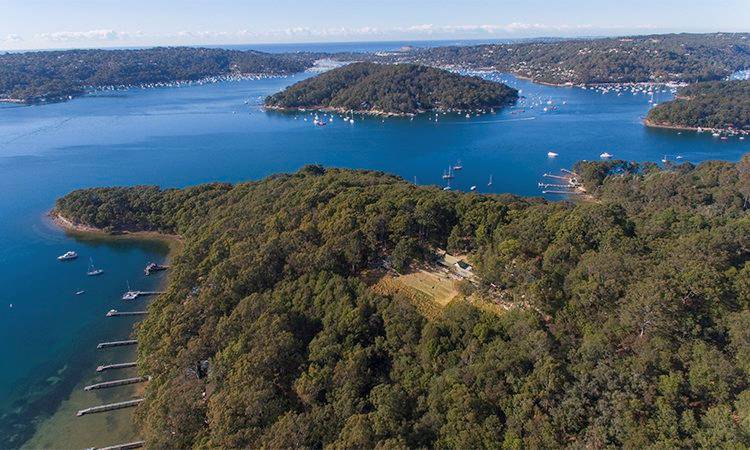
WHAT IS IT?
Bush Regeneration sees eco-conscious, kind hearted humans restore and rehabilitate the gorgeous, sprawling Aussie bush from its weed-infested, degraded state into a healthy, thriving plant community, which will prosper and delight forevermore. Far from just weed removal; Regenerators focus on habitat, drainage, weed sources and establishing native communities. These are big words which probably don’t make much sense – but we have an interactive learning opportunity for you!
WHERE IS IT?
Ku-ring-gai Chase National Park, Sydney’s protected north coast, is home to rock engravings, red ochre rock paintings, the fuzziest wildlife you ever did see and the most breathtaking views a Sydneysider or visitor could comprehend; and is currently under threat from invasive asparagus fern; which needs removing. Who knew your Auntie’s fave veggie could be so aggressive?
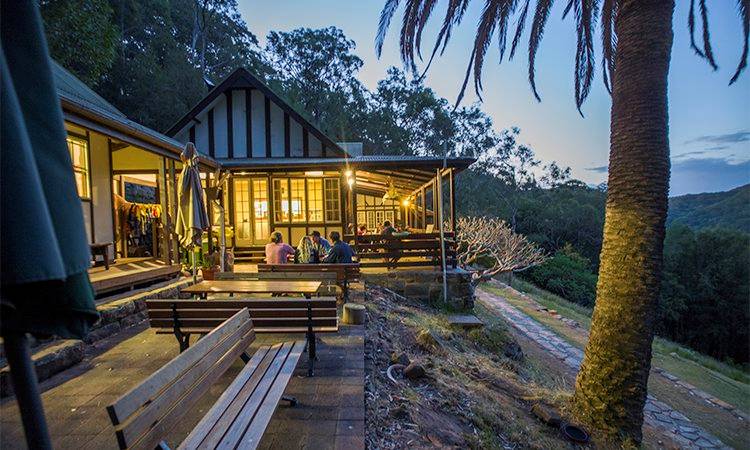
ALRIGHT - SIGN ME UP!
The blissed-out, babbling-brooked, spectacular-viewed, fresh-aired oasis that is our Pittwater YHA, alongside the Northern Beaches Council, are offering you fine green-thumbed and hearted folk the opportunity to volunteer alongside professional Regenerators for a weekend of Pittwater Restoration from May 11 – 13, 2018. Spend two mornings of tending to the gorgeous surrounds and you’ll be rewarded with two nights’ accommodation, two days of meals (morning teas, BBQ lunches and evening dinners) and kayak use throughout your stay. Plus, you’ll be chuffed with yourself for doing your bit for the planet and our futures.
Along with your towels, two sheets, a pillowcase and, sturdy shoes, sunscreen and your breakfasts; you’ll need a $20 contribution for the weekend. For all the T&Cs; head to Pittwater YHA, shoot them an email or give them a ring on (02 9999-5748) – the only thing those guys love more than a regenerated bushland is chatting to ladies and gentleman who are keen on the idea!
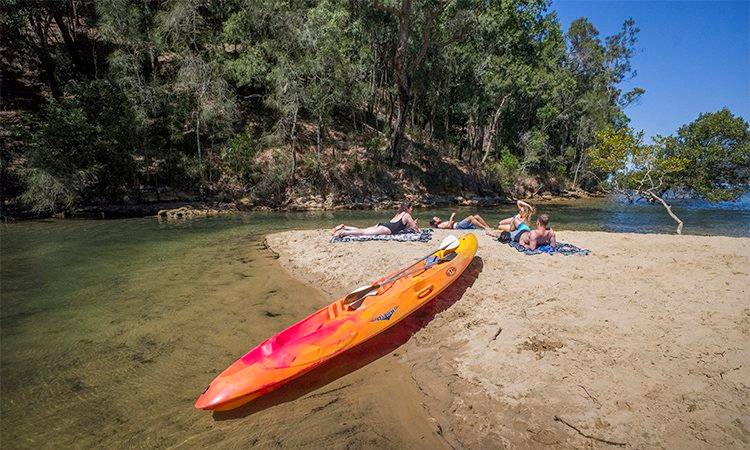
Pittwater YHA opens its doors to green-hearted and green-thumbed guests who'll save the gorgeous Ku-ring-gai Chase National Park from imminent asparagus fern invasion. Yes, seriously.

WHAT IS IT?
Bush Regeneration sees eco-conscious, kind hearted humans restore and rehabilitate the gorgeous, sprawling Aussie bush from its weed-infested, degraded state into a healthy, thriving plant community, which will prosper and delight forevermore. Far from just weed removal; Regenerators focus on habitat, drainage, weed sources and establishing native communities. These are big words which probably don’t make much sense – but we have an interactive learning opportunity for you!
WHERE IS IT?
Ku-ring-gai Chase National Park, Sydney’s protected north coast, is home to rock engravings, red ochre rock paintings, the fuzziest wildlife you ever did see and the most breathtaking views a Sydneysider or visitor could comprehend; and is currently under threat from invasive asparagus fern; which needs removing. Who knew your Auntie’s fave veggie could be so aggressive?

ALRIGHT - SIGN ME UP!
The blissed-out, babbling-brooked, spectacular-viewed, fresh-aired oasis that is our Pittwater YHA, alongside the Northern Beaches Council, are offering you fine green-thumbed and hearted folk the opportunity to volunteer alongside professional Regenerators for a weekend of Pittwater Restoration from May 11 – 13, 2018. Spend two mornings of tending to the gorgeous surrounds and you’ll be rewarded with two nights’ accommodation, two days of meals (morning teas, BBQ lunches and evening dinners) and kayak use throughout your stay. Plus, you’ll be chuffed with yourself for doing your bit for the planet and our futures.
Along with your towels, two sheets, a pillowcase and, sturdy shoes, sunscreen and your breakfasts; you’ll need a $20 contribution for the weekend. For all the T&Cs; head to Pittwater YHA, shoot them an email or give them a ring on (02 9999-5748) – the only thing those guys love more than a regenerated bushland is chatting to ladies and gentleman who are keen on the idea!

Aboriginal Community Members Sought For NPWS Regional Advisory Committees
April 13, 2018: NSW Office of Environment & HeritageNational Parks and Wildlife Service (NPWS) is seeking applications from Aboriginal people across NSW to nominate for membership of one of eight NPWS Regional Advisory Committees. Advisory committees provide independent advice to the OEH Chief Executive, NPWS Directors and to the National Parks and Wildlife Advisory Council.
Executive Director of NSW NPWS Robert Quirk said that this is an excellent opportunity for Aboriginal people with an interest in caring for and protecting the environment and heritage to be involved in the management of national parks and reserves into the future.
"Appointed by the Minister for the Environment, advisory committees provide a vital link between the NPWS and the community with members contributing their expertise and experience to inform park management and achieve conservation outcomes across NSW," Mr Quirk said.
"The advisory committees are highly valued for their advice about policies and plans, activities and proposed activities and for their input into draft plans of management helping to achieve the objects of the National Parks and Wildlife Act 1974.
"Each of the eight committees must include at least two Aboriginal people. Other community members with expertise and experience and expertise in one or more of the following areas are also encouraged to apply: local government, conservation, Aboriginal cultural heritage, rural or regional issues, agriculture, ecotourism or ecologically sustainable visitor or tourist use, environmental education and non-Aboriginal cultural heritage conservation or science qualifications in conservation biology, wildlife management or related disciplines to apply," Mr Quirk said.
The eight regional advisory committees cover every corner of New South Wales – the Blue Mountains, Hunter Central Coast, South Coast, West, Greater Sydney, North Coast, Northern Inland and the Southern Ranges.
Members are appointed by the Minister for the Environment in a voluntary capacity for terms of up to four years. Sitting fees are not paid, but approved expenses incurred in attending meetings or conducting regional advisory committee business are reimbursed by NPWS.
Applications close on Tuesday 1 May 2018.
Applications forms and more details are available at Advisory committees.
For more information email rac@environment.nsw.gov.au
Reward For Rainbows In Snowy Mountains And Oberon
April 10th 2018: NSW DPIIf snagging a feisty Rainbow Trout isn’t exciting enough, keen recreational anglers can now add further enjoyment to their fishing experience by receiving a reward for catching a tagged fish.
The Department of Primary Industries (DPI) has released 900 tagged yearling Rainbow Trout into Khancoban Pondage this month in the Snowy Mountains and will release a further 1000 tagged yearling Rainbow Trout into Oberon Dam in May.
DPI Senior Fisheries Manager Cameron Westaway said anglers who get their hands on a tagged fish should report their capture to DPI and will receive a trout lure in return.
“Recreational fishers who land one of these Rainbow Trout are asked to record their capture by phone or on the web,” Mr Westaway said.“This will let DPI Fisheries know survival and growth rates of the fish, allowing us to determine a size class of stocked fish that can avoid Redfin predation and improve stocking practices in the future.”
The trout, which were produced at DPI’s Gaden Trout Hatchery and the Dutton Trout Hatchery, average 25cm in length.
“Each fish has been released with a yellow external tag attached to them. Khancoban Pondage and Oberon Dam are renowned for great fishing and these fish will further boost recreational fishing opportunities in the area,” Mr Westaway said.
Fisheries experts at DPI believe the larger trout will do better in the presence of Redfin, which have had negative effect on both Khancoban and Oberon since they were illegally introduced.
“DPI is developing longer term stocking strategies for waters with Redfin. By stocking larger trout, they are too big for Redfin to prey on and will provide anglers with excellent catches,” Mr Westaway said.
Tagged fish recaptures can be recorded online. Recreational fishers are reminded that they are required to carry a NSW current recreational fishing fee receipt at all times while fishing.
Recreational fishers are encouraged to use the NSW Recreational Fishing Guide. Printed copies are available from DPI FisheriesOffices and most tackle shops.
Check out the FishSmart app, providing recreational fishers 24/7 smartphone access to essential information they need to know to fish in NSW.
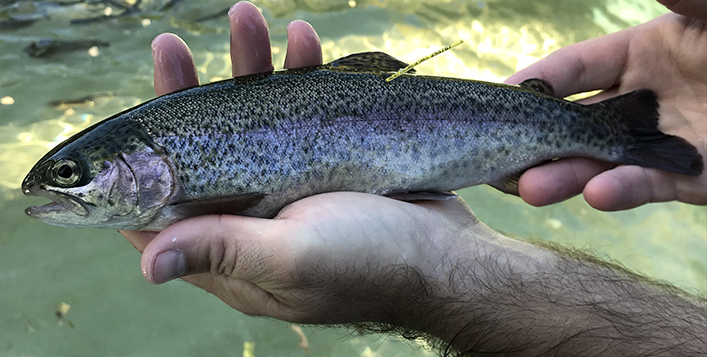
One of the 900 tagged Rainbow Trout released in Khancoban Pondage by the DPI - NSW DPI photo

Councils Encouraged To Apply For Funds As New NSW Coastal Legislation Commences
April 3, 2018: NSW Office of Environment & HeritageNSW Environment Minister Gabrielle Upton and Planning Minister Anthony Roberts have welcomed the commencement of the NSWCoastal Management Act.
The NSW Government worked with councils to deliver the new legislative and regulatory framework to support the coordinated planning and management of the State's coastal areas.
Minister for the Environment Gabrielle Upton said councils are being encouraged to take full advantage of the significant $83.6 million funding package available to support councils to implement the reforms.
"The introduction of the Act is another step towards a modern and integrated way of managing our exceptional coastal areas, to benefit our coastal communities and the whole of NSW," Ms Upton said.
"The new Coastal Management Manual is a key part of the reforms. It provides a step-by-step guidance to coastal councils for preparing coastal management programs with their communities."
Minister for Planning Anthony Roberts said the reform package sets out clear outcomes for our coastal areas that councils would apply to make better decisions for the benefit of our coastal communities, environments and economy.
"The new Act and state environmental planning policy are now more integrated and long-term focused and will improve the quality of on-ground actions and development in coastal areas," Mr Roberts said.
"Councils will be equipped to approach the coastal issues most important to their local communities using the best available science and strategic planning tools.
"Our new state environmental planning policy gives detailed guidance on planning considerations for our most valued and sensitive coastal assets. We also have detailed, interactive mapping that is far more user-friendly and supports better planning decisions."
Ms Upton said that the Act includes transitional provisions that allow councils to move towards the new arrangements over time.
"Many councils have already undertaken a significant amount of work to prepare coastal zone management plans under the current laws, and they will not be expected to start over," Ms Upton said.
"Councils that already have certified plans in place, or that have submitted plans for certification, will have until 2021 to update to a coastal management program.
The Office of Environment and Heritage and the Department of Planning will continue to support councils through this process with grant funding, operational guidance and expert technical advice.
Low-Interest Loans For Drought-Affected Farmers: NSW
April 9th, 2018: NSW GovernmentThe NSW Government's new Drought Transport Fund provides low-interest loans, with a two-year interest- and repayment-free period, to help farmers manage livestock through dry conditions. Eligible farmers can apply for low-interest loans of up to $20,000 to cover 100% of costs (GST exclusive) to transport stock, fodder or water to/from drought-affected properties. The first two years of a seven-year loan are interest and repayment free.
The Drought Transport Fund complements existing subsidies for the cost of transporting donated fodder within NSW and transporting stock off a property for animal welfare purposes.
These measures form part of the wider $300 million NSW DroughtStrategy, which includes:- a rural resilience program
- rural support workers and financial counselling
- the Farm Innovation Fund to help prepare for draught and improve permanent infrastructure.
The Farm Innovation Fund has approved $54 million worth of low-interest loans in the 2017-18 financial year, with almost $9 million worth of loans applied for in March 2018 alone, and more than $200 million since its inception in 2013.
Minister for Primary Industries Niall Blair said more than a third of the state is struggling with drought, and expressed particular concern for the Hunter, Central Tablelands, Central West and in the Far West of the state.
“Primary production is the lifeblood of the communities in these regions and when farmers are struggling, the whole community feels the impact," Mr Blair said.
"This additional step in our drought strategy will allow farmers to better manage core breeding stock, which will in turn enable a more rapid recovery when conditions improve.”
Learn more about services and support available to primary producers, their families and communities to prepare for and manage drought conditions
- a rural resilience program
- rural support workers and financial counselling
- the Farm Innovation Fund to help prepare for draught and improve permanent infrastructure.
Connecting Fish, Rivers And People: World Fish Migration Day 2018
With the World Fish Migration Day 2018 we want to raise global attention for endangered migratory fish, like salmon, sturgeon, giant catfish, dourado and eel. Migratory fish are particularly threatened by barriers such as weirs, dams and sluices, built for water management, hydropower and land drainage. These fish need free migration routes in order to survive. Water managers, fishery organizations and NGO's are restoring fish migration routes in rivers and between rivers and seas. Dams removed, sluices are managed fish friendly and fishway are built to help fish on their journey.
During this third World Fish Migration Day the participating organisations will open their doors for the public and will show fish and fishways and host activities for children and parents.
The event will take place on the 21st of April 2018 and is supported by WWF, The Nature Conservancy and Freshwater Fish Specialist Group. We are aiming for more than 500 participating local, regional and national organisations.
More here: www.worldfishmigrationday.com
Draft Plans Of Management For NSW Reserves, State And National Parks: Have Your Say
The Mother of Ducks Lagoon Nature Reserve Draft Plan of Management is now available for review and comment.Public exhibition of the draft plan provides an important opportunity for members of the community to have a say in the future management of Mother of Ducks Lagoon Nature Reserve.
The draft plan of management is on public exhibition until 18 June 2018 and anyone can review the plan and provide comments.
The Yanga National Park, Yanga State Conservation Area and Yanga Nature Reserve Draft Plan of Management is available for public review and comment. The exhibition of the draft plan provides an important opportunity for members of the community to have a say in future management directions for the park.
Submissions must be received by 23 April 2018.
The Toorale National Park and Toorale State Conservation Area Draft Plan of Management is available for public review and comment. The exhibition of the draft plan provides an important opportunity for members of the community to have a say in future management directions for the parks. Submissions must be received by 7 May 2018.
The Bobbiwaa Parks Draft Plan of Management covers Bobbiwaa State Conservation Area, Couradda National Park, Killarney State Conservation Area and Moema National Parkand is now available for public review and comment. The exhibition of the draft plan provides an important opportunity for members of the community to have a say in future management directions for these parks. Submissions must be received by 21 May 2018.
Bushcare in Pittwater
For further information or to confirm the meeting details for below groups, please contact Council's Bushcare Officer on 9970 1367
BUSHCARE SCHEDULES
Where we work Which day What time
Avalon
Angophora Reserve 3rd Sunday 8:30 - 11:30am
Avalon Dunes 1st Sunday 8:30 - 11:30am
Avalon Golf Course 2nd Wednesday 3 - 5:30pm
Careel Creek 4th Saturday 8:30 - 11:30am
Toongari Reserve 3rd Saturday 9 - 12noon (8 - 11am in summer)
Bangalley Headland 2nd Sunday 9 to 12noon
Bayview
Winnererremy Bay 4th Sunday 9 to 12noon
Bilgola
North Bilgola Beach 3rd Monday 9 - 12noon
Algona Reserve 1st Saturday 9 - 12noon
Plateau Park 1st Friday 8:30 - 11:30am
Church Point
Browns Bay Reserve 1st Tuesday 9 - 12noon
McCarrs Creek Reserve Contact Bushcare Officer To be confirmed
Clareville
Old Wharf Reserve 3rd Saturday 8 - 11am
Elanora
Kundibah Reserve 4th Sunday 8:30 - 11:30am
Mona Vale
Mona Vale Beach Basin 1st Saturday 8 - 11am
Mona Vale Dunes 2nd Saturday+3rd Thursday 8:30 - 11:30am
Newport
Bungan Beach 4th Sunday 9 - 12noon
Crescent Reserve 3rd Sunday 9 - 12noon
North Newport Beach 4th Saturday 8:30 - 11:30am
Porter Reserve 2nd Saturday 8 - 11am
North Narrabeen
Irrawong Reserve 2nd Saturday 2 - 5pm
Palm Beach
North Palm Beach Dunes 3rd Saturday 9 - 12noon
Scotland Island
Catherine Park 2nd Sunday 10 - 12:30pm
Elizabeth Park 1st Saturday 9 - 12noon
Pathilda Reserve 3rd Saturday 9 - 12noon
Warriewood
Warriewood Wetlands 1st Sunday 8:30 - 11:30am
Whale Beach
Norma Park 1st Friday 9 - 12noon
Western Foreshores
Coopers Point, Elvina Bay 2nd Sunday 10 - 1pm
Rocky Point, Elvina Bay 1st Monday 9 - 12noon
Bushcare in Pittwater
Where we work Which day What time
Avalon
Angophora Reserve 3rd Sunday 8:30 - 11:30am
Avalon Dunes 1st Sunday 8:30 - 11:30am
Avalon Golf Course 2nd Wednesday 3 - 5:30pm
Careel Creek 4th Saturday 8:30 - 11:30am
Toongari Reserve 3rd Saturday 9 - 12noon (8 - 11am in summer)
Bangalley Headland 2nd Sunday 9 to 12noon
Bayview
Winnererremy Bay 4th Sunday 9 to 12noon
Bilgola
North Bilgola Beach 3rd Monday 9 - 12noon
Algona Reserve 1st Saturday 9 - 12noon
Plateau Park 1st Friday 8:30 - 11:30am
Church Point
Browns Bay Reserve 1st Tuesday 9 - 12noon
McCarrs Creek Reserve Contact Bushcare Officer To be confirmed
Clareville
Old Wharf Reserve 3rd Saturday 8 - 11am
Elanora
Kundibah Reserve 4th Sunday 8:30 - 11:30am
Mona Vale
Mona Vale Beach Basin 1st Saturday 8 - 11am
Mona Vale Dunes 2nd Saturday+3rd Thursday 8:30 - 11:30am
Newport
Bungan Beach 4th Sunday 9 - 12noon
Crescent Reserve 3rd Sunday 9 - 12noon
North Newport Beach 4th Saturday 8:30 - 11:30am
Porter Reserve 2nd Saturday 8 - 11am
North Narrabeen
Irrawong Reserve 2nd Saturday 2 - 5pm
Palm Beach
North Palm Beach Dunes 3rd Saturday 9 - 12noon
Scotland Island
Catherine Park 2nd Sunday 10 - 12:30pm
Elizabeth Park 1st Saturday 9 - 12noon
Pathilda Reserve 3rd Saturday 9 - 12noon
Warriewood
Warriewood Wetlands 1st Sunday 8:30 - 11:30am
Whale Beach
Norma Park 1st Friday 9 - 12noon
Western Foreshores
Coopers Point, Elvina Bay 2nd Sunday 10 - 1pm
Rocky Point, Elvina Bay 1st Monday 9 - 12noon
Hundreds Of Scholarships To Improve Community Mental Health Care
Professional Learning Program 2018: Office Of The Children’s ESafety Commissioner
 This program includes three hours of professional learning through live webinar participation and the completion of a quiz.
This program includes three hours of professional learning through live webinar participation and the completion of a quiz.Professional Learning Program: Course Contents
- discuss and identify relationships and behaviours that may lead to harm
- identify teaching strategies and policies to encourage respectful online relationships, including:
- personal and social capacity building and
- techniques to assist in managing emotions and building an understanding of online resilience.
- understand the challenges of cyberbullying in the classroom
- identify a range of evidence-based strategies for preventing and dealing with cyberbullying issues when they occur, including:
- strategies for encouraging helpful bystander behaviour
- the process for reporting issues to the Office of the eSafety Commissioner.
- identify common risks when participating in online environments
- identify teaching strategies to encourage students to develop a personal approach to online safety, including:
- managing device and personal security settings
- managing serious breaches of privacy or security online
Register Your Newborn Baby Online: NSW
What Makes Someone Believe Or Reject Science? Quality Of Recordings
Why The Tasmanian Devil Might Be More Susceptible To Transmissible Cancers
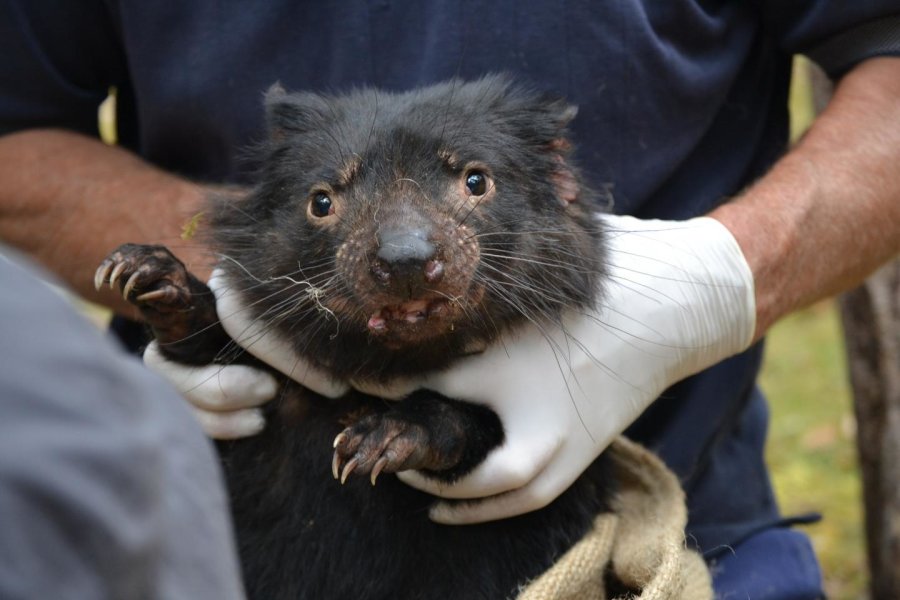
New 40km/H Speed Limit To Protect Emergency Workers
Conflict In Outer Space Will Happen, Legal Experts Warn

Opera Australia Triumphant At 2018 Green Room Awards
Construction Timelapse | La Bohème On Sydney Harbour
Call Out For Tech To Stop Drivers Using Mobile Phones: NSW
Most Primitive Kangaroo Ancestor Rediscovered After 30 Years In Obscurity
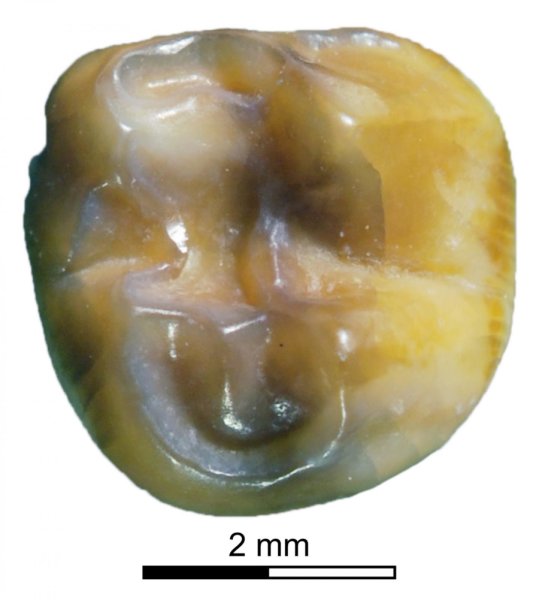
Disclaimer: These articles are not intended to provide medical advice, diagnosis or treatment. Views expressed here do not necessarily reflect those of Pittwater Online News or its staff.